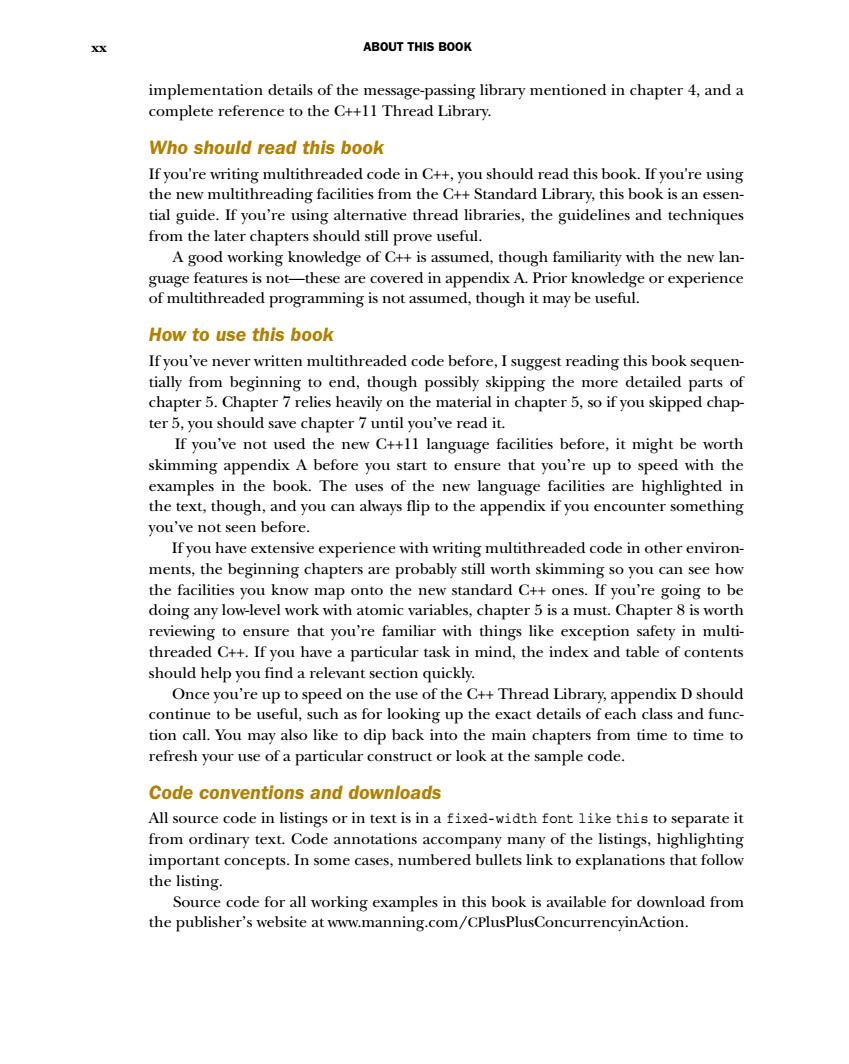正在加载图片...

XX ABOUT THIS BOOK implementation details of the message-passing library mentioned in chapter 4,and a complete reference to the C++11 Thread Library. Who should read this book If you're writing multithreaded code in C++,you should read this book.If you're using the new multithreading facilities from the C++Standard Library,this book is an essen- tial guide.If you're using alternative thread libraries,the guidelines and techniques from the later chapters should still prove useful. A good working knowledge of C++is assumed,though familiarity with the new lan- guage features is not-these are covered in appendix A.Prior knowledge or experience of multithreaded programming is not assumed,though it may be useful. How to use this book If you've never written multithreaded code before,I suggest reading this book sequen- tially from beginning to end,though possibly skipping the more detailed parts of chapter 5.Chapter 7 relies heavily on the material in chapter 5,so if you skipped chap ter 5,you should save chapter 7 until you've read it. If you've not used the new C++11 language facilities before,it might be worth skimming appendix A before you start to ensure that you're up to speed with the examples in the book.The uses of the new language facilities are highlighted in the text,though,and you can always flip to the appendix if you encounter something you've not seen before. If you have extensive experience with writing multithreaded code in other environ- ments,the beginning chapters are probably still worth skimming so you can see how the facilities you know map onto the new standard C++ones.If you're going to be doing any low-level work with atomic variables,chapter 5 is a must.Chapter 8 is worth reviewing to ensure that you're familiar with things like exception safety in multi- threaded C++.If you have a particular task in mind,the index and table of contents should help you find a relevant section quickly. Once you're up to speed on the use of the C++Thread Library,appendix D should continue to be useful,such as for looking up the exact details of each class and func- tion call.You may also like to dip back into the main chapters from time to time to refresh your use of a particular construct or look at the sample code. Code conventions and downloads All source code in listings or in text is in a fixed-width font like this to separate it from ordinary text.Code annotations accompany many of the listings,highlighting important concepts.In some cases,numbered bullets link to explanations that follow the listing. Source code for all working examples in this book is available for download from the publisher's website at www.manning.com/CPlusPlusConcurrencyinAction.xx ABOUT THIS BOOK implementation details of the message-passing library mentioned in chapter 4, and a complete reference to the C++11 Thread Library. Who should read this book If you're writing multithreaded code in C++, you should read this book. If you're using the new multithreading facilities from the C++ Standard Library, this book is an essential guide. If you’re using alternative thread libraries, the guidelines and techniques from the later chapters should still prove useful. A good working knowledge of C++ is assumed, though familiarity with the new language features is not—these are covered in appendix A. Prior knowledge or experience of multithreaded programming is not assumed, though it may be useful. How to use this book If you’ve never written multithreaded code before, I suggest reading this book sequentially from beginning to end, though possibly skipping the more detailed parts of chapter 5. Chapter 7 relies heavily on the material in chapter 5, so if you skipped chapter 5, you should save chapter 7 until you’ve read it. If you’ve not used the new C++11 language facilities before, it might be worth skimming appendix A before you start to ensure that you’re up to speed with the examples in the book. The uses of the new language facilities are highlighted in the text, though, and you can always flip to the appendix if you encounter something you’ve not seen before. If you have extensive experience with writing multithreaded code in other environments, the beginning chapters are probably still worth skimming so you can see how the facilities you know map onto the new standard C++ ones. If you’re going to be doing any low-level work with atomic variables, chapter 5 is a must. Chapter 8 is worth reviewing to ensure that you’re familiar with things like exception safety in multithreaded C++. If you have a particular task in mind, the index and table of contents should help you find a relevant section quickly. Once you’re up to speed on the use of the C++ Thread Library, appendix D should continue to be useful, such as for looking up the exact details of each class and function call. You may also like to dip back into the main chapters from time to time to refresh your use of a particular construct or look at the sample code. Code conventions and downloads All source code in listings or in text is in a fixed-width font like this to separate it from ordinary text. Code annotations accompany many of the listings, highlighting important concepts. In some cases, numbered bullets link to explanations that follow the listing. Source code for all working examples in this book is available for download from the publisher’s website at www.manning.com/CPlusPlusConcurrencyinAction